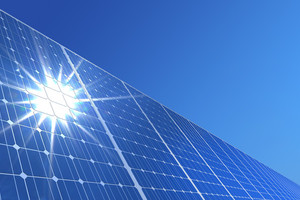
Two floating solar power plants capable of providing electricity for 1,000 homes have been completed in Japan. Solar power is booming in Japan; the nation doubled its solar power capacity within two years of the 2011 Fukushima nuclear disaster, and is now a world leader along with China and the US. While physicists continue to work on floating nuclear power plant designs, which would use ocean water to cool the reactor in the event of an emergency, in the meantime floating solar power plants are having a moment in the sun.
The latest such "mega-plants" at Nishihira and Higashihira Ponds in Kato City are the work of electronics giant Kyocera Corporation and Century Tokyo Leasing Corporation, and took just seven months to install. The plant's 11,250 modules are expected to generate 3,300 megawatt hours (MWh) every year.
According to Kyocera, besides being typhoon-proof (due to their sturdy, high-density polyethylene and array design) floating solar plants are superior to their land-based equivalents because of the cooling effect of the water, which allows them to function more efficiently. Reservoirs are also an ideal location because the panels produce shade, which reduces water evaporation and promotes algae growth. A report by Korea Water Resources Corporation found that the lower temperatures of the floating modules mean they are 11 percent more efficient than land-based equivalents. The report identified unsolved issues with the plants, too, however. It said the study had to discard data collected when the panels moved in the wind, and said research into new mooring systems was "continually needed".
The two ponds in Kato City generate a combined total of 2.9MW, and at one point represented the world's largest floating solar power plant project. In December 2014 Kyocera announced plans to break its own record, with the construction of a 13.4MW, 5,635 MWh per year solar power plant on the Yamakura Dam reservoir in Chiba Prefecture.
In March, however, Kyocera was itself usurped by an ambitious new plan announced by the Brazilian government. Brazil has said it will build an epic 350MW plant close to the existing Balbina hydroelectric power station, on the Amazon's Uatumã River. The current hydroelectric plant has faced fierce environmental criticism, but the Brazilian government maintains it can harness existing infrastructure to complete the comparatively vast project -- all while other governments are still messing around with "small water reservoirs". It also claims the plan is environmentally sound and that solar power is less vulnerable to drought.
Floating solar plants are not as exotic as they may sound. Some are starting to appear in the UK, while larger scale projects are also planned in California's wine country. Around 25 percent of Sonoma county's vineyards have ponds (to protect against flooding), and these are already proving to be ideal plant locations. In neighbouring Napa Valley, Far Niente Winery already has around 1,000 modules fixed to a pontoon on its land and others are due to follow suit. The floating plants help sustain the business, with excess power being fed back into the national grid.
